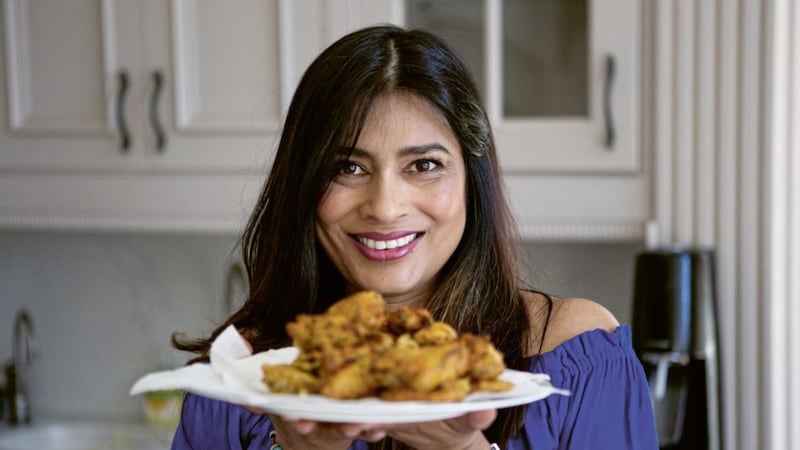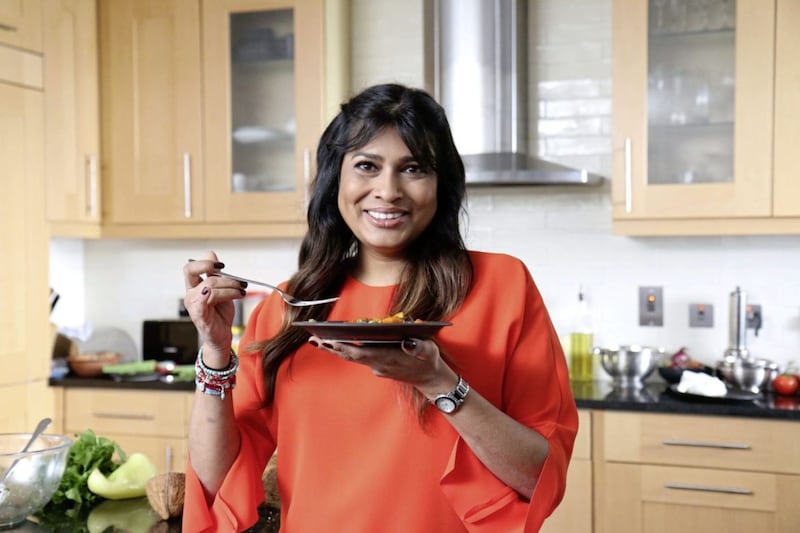NISHA KATONA is so impressive, any second you manage to snatch with her means you’re guaranteed to learn something, feel empowered and want to spend more electrifying minutes with her.
She is commanding, knows exactly what she’s trying to achieve and there’s a generosity to everything she does – be it the stories that accompany her recipes, the way she supports the staff in her restaurants, or her charm on telly.
The Wirral-based chef’s new cookbook, 30 Minute Mowgli, was born from lockdown cooking, when shopping was limited and ingredients restricted.
“I went into the cupboards and found the detritus, saving splendour hidden behind bottles of store cupboard ingredients,” remembers Katona (50).
“And I cooked as I do, which is really, really quick.” Time is short, understandably. Katona was a child protection barrister for 20 years before opening her first Mowgli restaurant in Liverpool in 2014. Now she has numerous branches (the latest just opened in London) and then there’s cookbooks to write, telly to do and her charitable Mowgli Trust to run.
30 Minute Mowgli is not just about using up ingredients. Things might be busy, but regardless, “We have big flavour requirements in our house,” she says.
“Big flavour is really important,” says Katona, and it’s not just her family (she has two daughters with husband Zoltan) demanding it of their food. “The British now want big, instant flavour; it’s not enough just to boil cabbage and serve it with butter, although that’s a beautiful thing as well.
“Sometimes you do want to have a bit of flair. And so it’s really important that we understand the way this nation eats has changed, and [is better] for it! That’s what makes us such an innovative nation and so cutting edge in so many ways, because we look at the way the world does things and we learn from it. And that includes big flavour.”
She feels a responsibility to share her inherited Bengali, and wider Indian, food knowledge. “We first-generation and second-generation Indians will pass away. What we need to do is make sure the British public who want to cook Indian food can authentically conjure it, because we’ve passed the formulas down.”
Katona continues: “It’s my ancestors’ – this way of cooking that I have, it’s thousands of years old… These came from my ancestors through my grandmother, through my great-grandmother, through my mother to me.” And now to us, via her recipes.
Katona learnt to speak Hungarian so she could cook her mother-in-law’s recipes. “I wanted to learn how to cook, so it started off with the language of the kitchen,” she says, likening the homely heart-warming Hungarian way of eating with her own Indian upbringing. “We both came from relatively poor backgrounds, you use every part of every ingredient – meat on the bone, you cook with thighs; we really cooked with the same sorts of ingredients,” says Katona, who shares several of her mother-in-law’s recipes in the book, including her little sparrow dumpling soup and paprika chicken.
And Katona really wastes nothing. In her opinion, broccoli stalks are the tastiest bit, bones stay in, and her grandmother’s best curry was actually a potato peel curry (“Can you imagine?!”) She also has a particular fondness for cabbages, because they’ll sit for two months in your fridge quite happily. “We mustn’t be afraid of food that is sitting there quietly, patiently waiting. This whip behind our feet of sell-by dates can be one of the worst things in terms of food wastage,” she says. “Look at it, smell it, has it grown its own ecosystem? If not, peel the outer leaves off and you’re away.”
Katona’s career in law has certainly helped shape how she eats and cooks. To learn the trade, “You have to sit around the table and eat with other barristers and judges and learn the ropes from them over food”, she explains, adding with a laugh: “Food has always been a big part of a lawyer’s life; very often you go for lunch and you negotiate your best deals over food, where people’s hearts and minds are a bit softened.”
That forensic mind is helpful when it comes to flavour-based decision making – like the time Katona blitzed up a gingerbread house and used it to coat lamb chops (“Heavenly”), and when she sloshed her gin and tonic over salmon as a marinade at a barbecue (“It was divine”). She says “idleness and cutting corners” can lead to some of the best inventions. The Rice Krispies in her snacky bhel puri aren’t a shortcut, though; they’re essential. “That is honestly how my family eat it.”
Throughout the book, Katona speaks of her ancestral home in India where instead of “normal toys” she learnt to prep fish on her Bengali grandmother’s veranda. “There weren’t acres of coloured plastic when I was growing up, so what you would do is you would scale fish, gut fish, wash fish; you would mince meat, make kebabs with your hands. Before you could speak, you’re mixing dough.”
She recalls fish scales going everywhere, all in her hair, and being able to make such a mess, because the whole veranda would be washed clean with a bucket of water and left to bake dry in the sun.
Then there’s her Indian fish finger sandwich recipe, inspired by long car journeys to McDonald’s in London in the late Seventies. “Honestly, we were driving for those fries and for a Filet-O-Fish – we felt as though they had made that specifically for the Indian community, and it’s still got a charm,” she says. Katona recalls how her mum would zhuzh her bun up with homemade green chilli pickle and slivers of red onion: “My mother still really reveres the Filet-O-Fish.” That’s some big, instant flavour we can definitely get behind.
30 Minute Mowgli by Nisha Katona is published by Nourish Books, priced £25. Photography Yuki Sugiura. Available now. Below are three recipes for you to try at home...
GINGERBREAD LAMB STEAKS
(Serves 4)
4tbsp vegetable oil
1 onion, roughly chopped
1 cube frozen crushed garlic or 3 garlic cloves, crushed
1 cube frozen crushed ginger or 1 thumb-sized pieces fresh ginger, peeled and grated
4 x 200g/7oz lamb rump steaks
1tbsp garam masala
1tbsp ground coriander
1tsp ground cinnamon
1tbsp salt
1tbsp sugar
4 ginger biscuits
Method:
Preheat the grill/broiler to high and line a grill pan with foil. Heat three tablespoons of the oil in a large non-stick frying pan/skillet over a medium heat, then add the onion, garlic and ginger and cook, stirring occasionally, for six to eight minutes, until the onions are soft and golden. Meanwhile, heat the remaining tablespoon of oil in a separate frying pan over a medium heat. Add the lamb steaks and cook for two to three minutes on each side, until browned. Transfer the lamb steaks to the rack of a grill pan while you prepare the topping. Add the garam masala, ground coriander, ground cinnamon, salt and sugar to the pan with the onions and cook, stirring continuously, for one minute. Tip the spiced onions into the bowl of a food processor and crumble in the ginger biscuits. Process the biscuit and onion mixture to a thick, smooth paste, then divide the mixture between the lamb steaks and spread out in an even layer. Grill/broil the steaks for four to five minutes, until the lamb is bubbling and the paste has formed a golden crust. Serve hot.
MANGO AND MINT FOOL
(Serves 4)
425g/15oz canned Alphonso mango pulp or tinned mango slices
Juice and zest of 1 lime
175ml/6fl oz double/heavy cream
2tsp caster/superfine sugar
3tbsp Greek yoghurt
2tbsp chopped fresh mint leaves
1tbsp toasted coconut flakes
Method:
Put the mango pulp or slices and lime juice into the bowl of a food processor and process until smooth. Set aside. Pour the double/heavy cream into a bowl and beat with an electric or handheld whisk until soft peaks form. Add the sugar, yoghurt and mint leaves to the bowl and fold through the cream, then add the mango pure?e and gently ripple it through the cream mixture. Spoon the mixture into serving bowls or glasses and transfer to fridge to set for 15–20 minutes, or longer if you want to make this ahead. Garnish the fools with the lime zest and toasted coconut flakes before serving.
CHICKEN, COCONUT AND PINEAPPLE CURRY
(Serves 4)
2 thumb-sized pieces fresh root ginger, peeled
5tbsp vegetable oil
2 onions, finely chopped
2 cloves garlic, crushed
3 skinless, boneless chicken breasts (approx. 600g/1lb 5oz), chopped into 2cm/3?4in cubes
2tbsp garam masala
1 heaped tsp ground coriander
1tsp ground turmeric
1?4tsp chilli powder
100g/31?2oz creamed coconut
400ml/14fl oz canned coconut milk
2 green chillies, finely sliced
1½tsp salt
1tsp brown sugar
10 chunks canned pineapple, cut into 1–2cm/1?2–3?4in pieces
100g/31?2oz roasted salted cashew nuts
Small handful fresh coriander/cilantro, finely chopped, to garnish
1 red chilli, finely sliced, to garnish
Cooked rice, or flatbreads, to serve
Method:
Finely mince one of the pieces of ginger and slice the other into fine matchsticks. Set aside. Heat the oil in a large pan over a medium heat. Add the onions, garlic and minced ginger and fry, stirring continuously, for eight minutes, until golden brown. Add the chicken to the pan and stir to combine with the onions, then add the garam masala, ground coriander, ground turmeric and chilli powder. Cook, stirring occasionally, for five minutes, to seal the chicken and coat it in the spices. Add the creamed coconut, coconut milk, ginger matchsticks, sliced chillies, salt, sugar, pineapple and cashews to the pan and stir to combine, adding a little of the juice from the canned pineapple if the mixture is too dry. Leave to cook, stirring occasionally, for five to 10 minutes, until the chicken is cooked through. Scatter with chopped coriander/cilantro and sliced red chilli, then serve hot with rice or wraps alongside.




